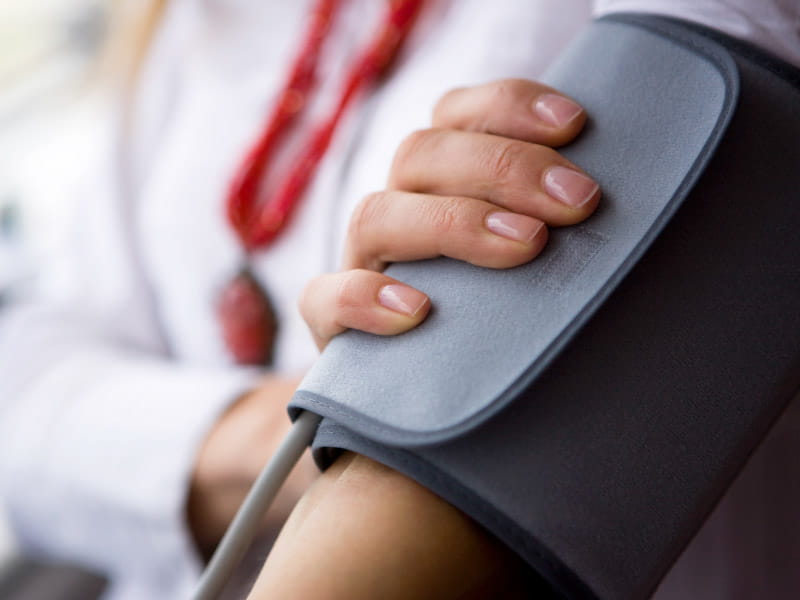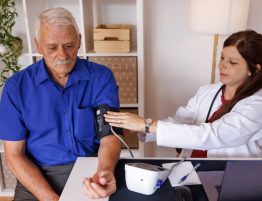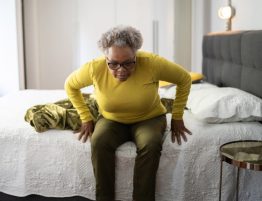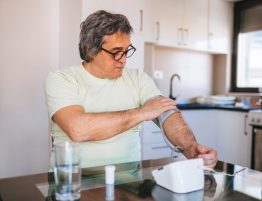
The simple act of having someone lie down for a blood pressure reading might reveal more than expected about their heart health, preliminary research has found.
Using data from a large, long-running study, researchers discovered that when compared with readings taken while someone was sitting, readings that showed high blood pressure in people who were lying down did a better job of predicting stroke, serious heart problems and death.
The results will be presented Saturday at the American Heart Association’s Hypertension Scientific Sessions in Boston. The work is considered preliminary until full findings are published in a peer-reviewed journal.
Dr. Stephen Juraschek, senior researcher on the work, said the findings were surprising and suggest that having people lie flat to measure their blood pressure could potentially help identify people who need treatment despite seemingly normal readings taken while seated.
Managing high blood pressure, or hypertension, has long been understood to be an essential part of heart health. But getting an accurate reading from a seated position can be complicated, said Juraschek, a general internist at Beth Israel Deaconess Medical Center in Boston and an associate professor at Harvard Medical School.
As defined by the AHA and American College of Cardiology, normal blood pressure for adults measured in a seated position is a systolic reading of less than 120 mmHg and a diastolic reading under 80 mmHg. Readings fluctuate throughout the day, though.
Juraschek said the “gold standard” for accuracy is ambulatory blood pressure, which takes readings throughout the day. But that requires wearing a monitor for 24 hours.
Over the years, he said, research has shown “time and time again” that nighttime blood pressure measurements are one of the best predictors of cardiovascular disease. But it’s hard to get such readings. “It’s not comfortable to have your arm compressed repeatedly overnight,” he said. “It can affect your sleep.”
Juraschek and his colleagues wanted to lay the groundwork for determining whether simply having people lie down in the clinic during the day might identify those at higher risk of cardiovascular disease, similar to blood pressure measurements taken during sleep.
They started by comparing readings taken while seated with those taken while lying down, or supine.
Researchers turned to data from 11,369 participants in the Atherosclerosis Risk in Communities Study. Their blood pressure had been measured while they were seated and also when they were lying down.
The participants’ average age was 54, and they had been followed for a median 25 to 28 years. People with a history of heart disease, heart failure or stroke were excluded. More than half of the participants were women and one-fourth were Black.
The participants were divided into four groups: One group had normal blood pressure readings both when seated and lying down. One had high blood pressure only while sitting. The third – which made up 16% of participants – had high blood pressure only while lying down. And the fourth had high blood pressure in both positions.
Over time, the group without high blood pressure in either position had the lowest risk. The group with high blood pressure in both positions consistently was at high risk.
But unexpectedly, Juraschek said, the group that had high blood pressure only while lying down had risk levels similar to those with high readings in both positions, even after accounting for other cardiovascular risk factors. People with supine-only high blood pressure had a 53% higher risk of coronary heart disease, 51% higher risk of heart failure, 62% higher risk for stroke, 78% higher risk of fatal coronary heart disease, and 34% higher risk of death from all causes compared to participants with normal blood pressure in both positions.
The risk of problems predicted by supine blood pressure, “in every single case, was more important than the seated, and in many cases was very close to having elevation in both,” Juraschek said.
The findings imply that checking supine blood pressure might unveil hypertension that would otherwise be missed in the doctor’s office, he said. But he added that much more research would need to be done first.
Dr. Wanpen Vongpatanasin, a professor of medicine at UT Southwestern Medical Center in Dallas, called the study important but agreed that more research is needed.
Previous work has shown that nighttime blood pressure independently predicts cardiovascular outcomes, but it has been unclear whether that was related to timing of the readings or the position of the person being measured, said Vongpatanasin, who is director of UT Southwestern’s Hypertension Fellowship Program. She was not involved in the new research.
“This study suggests that supine blood pressure may be one explanation, as it has as much impact on long-term cardiovascular outcome as seated blood pressure,” she said.
The findings highlight the importance of control of blood pressure in all body positions, Vongpatanasin said. But she said it is too early to make treatment decisions based on supine readings. There also are practical considerations with trying to find time to add such readings in a busy clinical practice, she said.
Juraschek acknowledged that one of the study’s limitations was that in the initial measurement, patients had been lying down for about 20 minutes, which is much longer than would happen in a typical doctor’s visit.
But, he said, “I do think this is a simple enough assessment that people could be empowered to check on their own, and people could use it in screening as well.”
The study was not designed to look at possible explanations for the differing readings. Juraschek speculated that several factors could be responsible for these findings, ranging from the possibility that getting an accurate reading is easier when a patient is relaxed and lying down to the physics of how fluids move around the body when it’s flat as opposed to seated.
With more studies and more information, supine blood pressure could help spot hypertension in people whose treatment is delayed because they’ve been “flying under the radar,” he said. It also could identify people who might not need treatment.
But for now, Juraschek said, monitoring seated blood pressure will remain key. “There’s such a large body of evidence about treatment of seated blood pressure that we just can’t ignore.”







